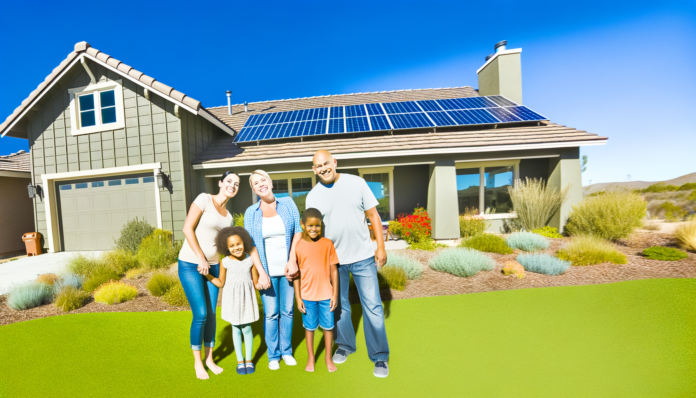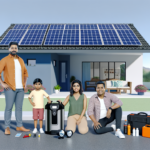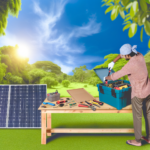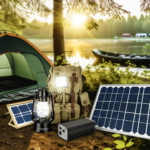Introduction to Solar Power
The Importance of Reducing Your Carbon Footprint
In today’s world, the urgency to reduce our carbon footprint has never been greater. Climate change, driven by the excessive release of greenhouse gases, poses a significant threat to our planet. By minimizing our carbon emissions, we can mitigate the adverse effects of global warming, such as extreme weather events, rising sea levels, and loss of biodiversity. One of the most effective ways to achieve this is by transitioning to renewable energy sources, with solar power being a leading contender.
How Solar Power Works
Solar power harnesses the energy from the sun and converts it into electricity using photovoltaic (PV) cells. These cells are typically made from silicon and are arranged in panels. When sunlight hits the PV cells, it excites the electrons in the silicon, creating an electric current. This process is known as the photovoltaic effect. The generated direct current (DC) electricity is then converted into alternating current (AC) by an inverter, making it suitable for home use. Given India’s sunny climate, solar power is a particularly viable and efficient energy solution.
Benefits of Solar Energy
The advantages of solar energy are manifold, making it an attractive option for homeowners and businesses alike:
- Environmental Impact: Solar energy is a clean, renewable resource that significantly reduces greenhouse gas emissions. By replacing fossil fuels with solar power, we can decrease air pollution and combat climate change.
- Cost Savings: While the initial investment in solar panels can be substantial, the long-term savings on electricity bills are considerable. In many cases, solar power systems pay for themselves within five to eight years.
- Energy Independence: Solar power provides a degree of energy independence, reducing reliance on the grid and protecting against rising energy costs. This is particularly beneficial in remote areas where access to the grid is limited.
- Low Maintenance: Solar power systems require minimal maintenance. Regular cleaning and occasional inspections are usually sufficient to keep the system running efficiently.
- Increased Property Value: Homes equipped with solar power systems often see an increase in property value. Prospective buyers are attracted to the promise of lower energy bills and a reduced carbon footprint.
In conclusion, solar power offers a practical and sustainable solution to reducing our carbon footprint. By understanding how solar energy works and recognizing its numerous benefits, we can make informed decisions that contribute to a greener and more sustainable future.
Assessing Your Solar Needs
Evaluating Your Energy Consumption
Before diving into solar power, it’s crucial to understand your current energy consumption. This step helps you determine the size and type of solar system that will best meet your needs. Start by reviewing your electricity bills over the past year to identify your average monthly and annual energy usage. Pay attention to seasonal variations, as energy consumption can fluctuate with changes in weather and daylight hours.
To get a more detailed understanding, consider using an energy monitoring device. These devices can provide real-time data on your energy usage, helping you identify which appliances or systems consume the most power. By knowing your energy consumption patterns, you can make informed decisions about the capacity and configuration of your solar power system.
Determining the Right Solar Setup for You
Once you have a clear picture of your energy consumption, the next step is to determine the right solar setup for your home. Several factors influence this decision, including your budget, roof space, and energy goals.
1. **System Size**: The size of your solar system should match your energy needs. A typical residential solar system ranges from 3 kW to 10 kW. To calculate the appropriate size, divide your annual energy consumption (in kWh) by the number of peak sunlight hours your location receives annually. This will give you an estimate of the system capacity required.
2. **Roof Space and Orientation**: The amount of available roof space and its orientation significantly impact the efficiency of your solar panels. South-facing roofs in the Northern Hemisphere receive the most sunlight, but east and west-facing roofs can also be effective. Ensure there are no significant obstructions like trees or buildings that could cast shadows on your panels.
3. **Budget and Financing**: Solar power systems can be a significant investment, but various financing options are available, including loans, leases, and power purchase agreements (PPAs). Evaluate these options to find one that aligns with your financial situation and long-term goals.
4. **Energy Goals**: Consider whether you want to offset your entire electricity usage or just a portion of it. Some homeowners aim for complete energy independence, while others are content with reducing their utility bills.
Understanding Solar Panel Efficiency
Solar panel efficiency is a critical factor in determining how much electricity your system can generate. Efficiency refers to the percentage of sunlight that a solar panel can convert into usable electricity. Higher efficiency panels produce more power in a given amount of space, which can be particularly beneficial if you have limited roof space.
1. **Types of Solar Panels**: There are three main types of solar panels: monocrystalline, polycrystalline, and thin-film. Monocrystalline panels are the most efficient, with efficiency rates typically between 15-20%. Polycrystalline panels are slightly less efficient, ranging from 13-16%, but they are also more affordable. Thin-film panels have the lowest efficiency, around 10-12%, but they are lightweight and flexible, making them suitable for specific applications.
2. **Temperature Coefficient**: Solar panel efficiency can decrease with rising temperatures. The temperature coefficient indicates how much the efficiency drops for each degree increase in temperature. Panels with a lower temperature coefficient are better suited for hot climates.
3. **Degradation Rate**: Over time, solar panels gradually lose their efficiency. The degradation rate measures this loss, typically around 0.5-1% per year. High-quality panels have lower degradation rates, ensuring better long-term performance.
4. **Manufacturer and Warranty**: Choose panels from reputable manufacturers that offer robust warranties. A typical warranty covers 25 years for performance and 10-12 years for product defects. Reliable warranties provide peace of mind and protect your investment.
By carefully evaluating your energy consumption, determining the right solar setup, and understanding solar panel efficiency, you can make informed decisions that will maximize the benefits of your solar power system.
Choosing the Right Solar Equipment
Types of Solar Panels
Selecting the right type of solar panel is crucial for maximizing efficiency and meeting your energy needs. There are three main types of solar panels to consider:
- Monocrystalline Panels: These panels are made from a single crystal structure, offering the highest efficiency rates and a sleek, uniform appearance. They are ideal for homes with limited roof space but come at a higher cost.
- Polycrystalline Panels: Made from multiple crystal structures, these panels are less efficient than monocrystalline panels but are more affordable. They have a bluish hue and are a good option for those with ample roof space.
- Thin-Film Panels: These panels are lightweight and flexible, making them suitable for unconventional spaces. While they are less efficient and require more space, they are often the most cost-effective option.
Inverters and Batteries
Inverters and batteries are essential components of a solar power system, converting and storing the energy generated by your panels.
- Inverters: The inverter converts the direct current (DC) produced by solar panels into alternating current (AC), which is used by most household appliances. There are three main types of inverters:
- String Inverters: These are the most common and cost-effective, suitable for homes with minimal shading issues.
- Microinverters: Installed on each panel, they offer better performance in shaded conditions but are more expensive.
- Power Optimizers: These work with string inverters to optimize the performance of each panel, balancing cost and efficiency.
- Batteries: Solar batteries store excess energy generated during the day for use at night or during power outages. The two main types are:
- Lithium-Ion Batteries: Known for their long lifespan and high efficiency, they are more expensive but offer better performance.
- Lead-Acid Batteries: More affordable but with a shorter lifespan and lower efficiency, they are suitable for budget-conscious users.
Portable vs. Fixed Solar Solutions
When choosing solar equipment, you must decide between portable and fixed solar solutions based on your lifestyle and energy needs.
- Portable Solar Solutions: These are ideal for those who need a flexible and mobile power source. Portable solar panels can be used for camping, RVs, or emergency backup. They are easy to set up and transport but generally offer lower power output compared to fixed systems.
- Fixed Solar Solutions: These systems are permanently installed on rooftops or ground mounts. They provide a stable and consistent power supply, making them suitable for residential and commercial use. Fixed systems are more efficient and can generate more power, but they require a higher initial investment and professional installation.
By understanding the different types of solar panels, inverters, and batteries, as well as the pros and cons of portable versus fixed solar solutions, you can make an informed decision that best suits your energy needs and budget.
Installation and Maintenance
DIY Installation vs. Professional Installation
When it comes to installing solar panels, you have two primary options: DIY installation and professional installation. Each has its own set of advantages and considerations.
DIY Installation:
- Cost Savings: One of the most significant benefits of DIY installation is the potential for cost savings. By doing the work yourself, you can avoid labor costs associated with professional services.
- Learning Experience: Installing your own solar panels can be a rewarding educational experience. You’ll gain a deeper understanding of how solar energy systems work.
- Flexibility: DIY installation allows you to work at your own pace and schedule, which can be convenient if you have a busy lifestyle.
However, DIY installation also comes with challenges. It requires a certain level of technical skill and knowledge. Mistakes during installation can lead to inefficiencies or even damage to the system, which could negate any cost savings.
Professional Installation:
- Expertise: Professional installers have the experience and knowledge to ensure that your solar panels are installed correctly and efficiently.
- Warranty and Support: Many professional installations come with warranties and ongoing support, providing peace of mind and protection for your investment.
- Time-Saving: Hiring professionals can save you a significant amount of time and effort, allowing you to focus on other tasks.
While professional installation may be more expensive upfront, the long-term benefits and assurances often outweigh the initial costs.
Basic Maintenance Tips
Maintaining your solar panels is crucial for ensuring their longevity and efficiency. Here are some basic maintenance tips to keep your system running smoothly:
- Regular Cleaning: Dust, dirt, and debris can accumulate on your solar panels, reducing their efficiency. Clean your panels with water and a soft brush or cloth every few months, or more frequently if you live in a particularly dusty area.
- Inspect for Damage: Periodically inspect your solar panels for any signs of damage, such as cracks or loose connections. Address any issues promptly to prevent further damage.
- Monitor Performance: Keep an eye on your system’s performance through monitoring software or apps. Sudden drops in energy production can indicate a problem that needs attention.
- Trim Nearby Trees: Ensure that trees or other vegetation do not cast shadows on your panels, as shading can significantly reduce their efficiency.
Troubleshooting Common Issues
Even with regular maintenance, you may encounter some common issues with your solar energy system. Here are a few troubleshooting tips:
- Low Energy Output: If you notice a drop in energy production, check for obstructions like dirt or debris on the panels. Also, ensure that all connections are secure and that the inverter is functioning correctly.
- Inverter Issues: The inverter is a critical component that converts the DC electricity generated by your panels into AC electricity for your home. If the inverter’s display shows an error message, consult the user manual or contact the manufacturer for guidance.
- Grid Connection Problems: If your system is not feeding electricity back into the grid, there may be an issue with the grid connection. Check the connection points and consult with your utility provider if necessary.
- Weather-Related Damage: Severe weather conditions, such as hail or heavy snow, can damage your panels. Inspect your system after such events and address any damage immediately.
By following these installation and maintenance guidelines, you can ensure that your solar energy system operates efficiently and continues to reduce your carbon footprint for years to come.
Maximizing Solar Efficiency
Optimal Placement of Solar Panels
The placement of solar panels is crucial for maximizing their efficiency. Ideally, solar panels should be installed in a location that receives the most sunlight throughout the day. For those in the Northern Hemisphere, this typically means positioning panels to face south. However, the exact angle and orientation can vary based on your geographic location and the specific characteristics of your site.
**Key considerations for optimal placement include:**
– **Roof Angle and Orientation:** The tilt of your roof can significantly impact the amount of sunlight your panels receive. A professional installer can help determine the best angle for your panels.
– **Shading:** Avoid areas that are frequently shaded by trees, buildings, or other obstructions. Even partial shading can drastically reduce the efficiency of your solar panels.
– **Ground-Mounted Systems:** If your roof is not suitable for solar panels, consider ground-mounted systems. These can be placed in open areas with optimal sun exposure and can be adjusted for the best angle.
Seasonal Adjustments
Solar panel efficiency can vary with the seasons due to changes in the sun’s position and weather conditions. Making seasonal adjustments can help maintain optimal performance throughout the year.
**Tips for seasonal adjustments:**
– **Adjusting Tilt Angle:** In the winter, the sun is lower in the sky, so tilting your panels at a steeper angle can capture more sunlight. Conversely, in the summer, a shallower angle is more effective.
– **Cleaning Panels:** Snow, leaves, and debris can accumulate on your panels, especially during fall and winter. Regular cleaning ensures that your panels are not obstructed and can operate at peak efficiency.
– **Monitoring Performance:** Use monitoring systems to track the performance of your solar panels. This data can help you make informed decisions about when and how to adjust your system.
Energy Storage Solutions
Energy storage solutions, such as batteries, are essential for maximizing the efficiency and reliability of your solar power system. They allow you to store excess energy generated during the day for use at night or during periods of low sunlight.
**Types of energy storage solutions:**
– **Lithium-Ion Batteries:** These are the most common type of battery used in residential solar systems. They offer high energy density, long life, and relatively low maintenance.
– **Lead-Acid Batteries:** While less expensive than lithium-ion batteries, lead-acid batteries have a shorter lifespan and lower energy density. They are often used in off-grid systems where cost is a significant factor.
– **Flow Batteries:** These are a newer technology that offers the potential for longer life and greater scalability. They are currently more expensive but may become more viable as the technology advances.
**Benefits of energy storage:**
– **Energy Independence:** With a battery storage system, you can reduce your reliance on the grid and ensure a continuous power supply during outages.
– **Cost Savings:** Storing excess energy can help you avoid peak electricity rates by using stored energy during high-demand periods.
– **Environmental Impact:** By storing and using your solar energy, you reduce the need for fossil fuel-based power, further decreasing your carbon footprint.
By focusing on optimal placement, making seasonal adjustments, and incorporating energy storage solutions, you can significantly enhance the efficiency and effectiveness of your solar power system. These steps not only maximize your energy production but also contribute to a more sustainable and resilient energy future.
Living Off-Grid with Solar Power
Benefits of Off-Grid Living
Living off-grid with solar power offers numerous advantages that extend beyond mere financial savings. Here are some key benefits:
- Energy Independence: By generating your own electricity, you become self-sufficient and less reliant on external power sources. This independence can be particularly valuable in remote areas where grid access is limited or unreliable.
- Environmental Impact: Off-grid solar systems significantly reduce your carbon footprint by utilizing renewable energy. This helps combat climate change and promotes a cleaner, greener planet.
- Cost Savings: While the initial investment in solar equipment can be high, the long-term savings on electricity bills can be substantial. Additionally, you are insulated from rising energy costs.
- Resilience: Off-grid systems provide a reliable power source during natural disasters or grid failures, ensuring that you have continuous access to electricity.
Essential Off-Grid Solar Equipment
Setting up an off-grid solar system requires careful selection of various components to ensure efficiency and reliability. Here are the essential pieces of equipment:
- Solar Panels: These are the primary source of energy, converting sunlight into electricity. High-quality panels with high efficiency and durability are crucial.
- Inverters: Inverters convert the DC electricity generated by solar panels into AC electricity, which is used by most household appliances. Choose inverters that are reliable and compatible with your system.
- Batteries: Batteries store excess energy generated during the day for use at night or during cloudy periods. Lithium-ion batteries are popular for their long lifespan and high efficiency.
- Charge Controllers: These devices regulate the voltage and current coming from the solar panels to the batteries, preventing overcharging and extending battery life.
- Backup Generators: In case of prolonged periods of low sunlight, a backup generator can provide additional power to ensure continuous electricity supply.
Case Studies and Success Stories
Real-world examples can provide valuable insights into the practicalities and benefits of living off-grid with solar power. Here are a few success stories:
Case Study 1: Remote Farm in Queensland, Australia
A remote farm in Queensland successfully transitioned to off-grid living with a solar power system designed by Springers Solar. The system includes high-efficiency solar panels, lithium-ion batteries, and a backup generator. Despite the farm’s remote location, the system provides reliable power, significantly reducing energy costs and environmental impact.
Case Study 2: Suburban Home in California, USA
A suburban home in California opted for an off-grid solar system to achieve energy independence and reduce electricity bills. The system features monocrystalline solar panels, a hybrid inverter, and advanced battery storage. The homeowners report substantial savings and a reduced carbon footprint, along with the peace of mind that comes from being less reliant on the grid.
Case Study 3: Eco-Friendly Cabin in British Columbia, Canada
An eco-friendly cabin in British Columbia was equipped with an off-grid solar system to support sustainable living. The system includes polycrystalline solar panels, a robust battery bank, and a small wind turbine for additional power. The cabin operates entirely off-grid, showcasing the viability of renewable energy solutions in diverse climates and settings.
These case studies highlight the versatility and effectiveness of off-grid solar systems in various environments, demonstrating that with the right planning and equipment, off-grid living is not only feasible but also highly rewarding.
Future Trends in Solar Technology
Emerging Solar Technologies
The solar industry is continuously evolving, with new technologies promising to enhance efficiency and broaden the applications of solar power. One of the most exciting developments is the advent of **perovskite solar cells**. These cells offer higher efficiency rates at a lower cost compared to traditional silicon-based cells. Their flexibility and lightweight nature make them suitable for a variety of applications, from rooftops to portable devices.
Another groundbreaking innovation is **solar windows**. These transparent photovoltaic windows can generate electricity while still allowing light to pass through, making them ideal for urban environments where space is limited. By integrating solar cells into window glass, buildings can harness solar energy without compromising aesthetics.
**Bifacial solar panels** are also gaining traction. Unlike traditional panels that capture sunlight on one side, bifacial panels can absorb light from both sides, increasing energy generation by up to 30%. This makes them particularly effective in environments with reflective surfaces, such as snowy or sandy areas.
Innovations in Solar Storage
Effective energy storage is crucial for maximizing the benefits of solar power, especially given its intermittent nature. Recent advancements in **battery technology** are making solar storage more efficient and affordable. Modern lithium-ion batteries, for instance, offer higher energy densities and longer lifespans, making them ideal for both residential and commercial solar systems.
**Flow batteries** are another promising technology. These batteries store energy in liquid electrolytes contained in external tanks, allowing for scalable storage solutions. They are particularly useful for large-scale solar farms and grid applications due to their long cycle life and ability to discharge energy over extended periods.
**Smart grids** are also playing a pivotal role in solar storage. By using artificial intelligence and advanced algorithms, smart grids can balance supply and demand more efficiently, integrating solar energy seamlessly into the existing power infrastructure. This not only enhances grid stability but also optimizes the use of stored solar energy.
The Role of Solar in Sustainable Living
Solar technology is not just about generating electricity; it plays a vital role in promoting sustainable living. By reducing reliance on fossil fuels, solar energy helps lower carbon emissions, contributing to the fight against climate change. The integration of solar power into **smart home systems** allows for automated energy management, optimizing energy use based on real-time data and reducing overall consumption.
**Solar-powered transportation** is another area where solar technology is making significant strides. Solar panels are being integrated into electric vehicles, boats, and even aircraft, reducing the need for conventional fuels and lowering the carbon footprint of transportation.
Moreover, solar energy is fostering **energy independence**. By generating their own electricity, homes and businesses can reduce their reliance on the grid, making them less vulnerable to power outages and fluctuations in energy prices. This is particularly beneficial in remote or disaster-prone areas where reliable power supply is crucial.
In summary, the future of solar technology is bright, with continuous innovations enhancing its efficiency, storage capabilities, and applications. As these technologies become more accessible and affordable, solar power will play an increasingly central role in sustainable living, helping to create a cleaner, greener future for all.






